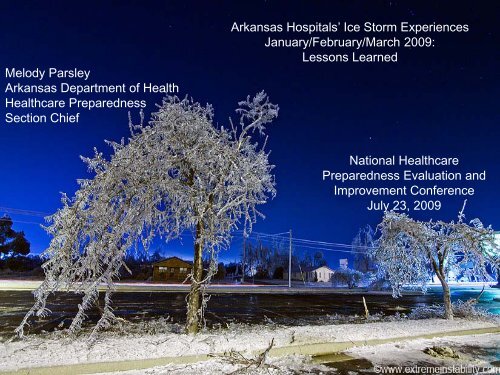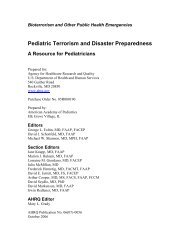Ice Storm Experiences - PHE
Ice Storm Experiences - PHE
Ice Storm Experiences - PHE
You also want an ePaper? Increase the reach of your titles
YUMPU automatically turns print PDFs into web optimized ePapers that Google loves.
Melody Parsley<br />
Arkansas Department of Health<br />
Healthcare Preparedness<br />
Section Chief<br />
Arkansas Hospitals’ <strong>Ice</strong> <strong>Storm</strong> <strong>Experiences</strong><br />
January/February/March 2009:<br />
Lessons Learned<br />
National Healthcare<br />
Preparedness Evaluation and<br />
Improvement Conference<br />
July 23, 2009
• A cold front stalled along the Gulf<br />
Coast on January 24th/25 th. The<br />
system drove moisture northward<br />
over the front, with precipitation<br />
breaking out late on the 26th/early<br />
on the 27th. It was cold enough for<br />
areas of freezing rain and sleet<br />
across northern and central<br />
Arkansas.
• The dire situation was summed up by Mel<br />
Coleman, CEO of North Arkansas Electric<br />
Cooperative (on the night of the 27th):<br />
• "In all of my years I have never seen anything that<br />
compares to the damage this storm has caused.<br />
From the beginning forecasts yesterday morning<br />
it seemed the worst could happen, but we tried to<br />
believe it wouldn't happen. It did happen.... Just<br />
opening the door to the outside sounds like a war<br />
zone, with the continuous sounds of trees and<br />
limbs breaking...like gunshots over the next hill. “
*Approximately 350,000 homes and businesses<br />
without power<br />
* About 32,200 poles were downed or snapped during<br />
the event<br />
* As many as 18 fatalities were reported across the<br />
state, due to hypothermia, post-event hazards (i.e.<br />
downed trees/power lines) or traffic related<br />
* At one point, 12 hospitals were without power and<br />
two hospitals were without water.
*Approximately 350,000 homes and businesses<br />
without power<br />
* About 32,200 poles were downed or snapped during<br />
the event<br />
* As many as eighteen fatalities were reported across<br />
the state, due to hypothermia, post-event hazards (i.e.<br />
downed trees/power lines) or traffic related<br />
* At one point, 12 hospitals were without power and<br />
two hospitals were without water.
What went wrong?<br />
•Sustained power outage; Ran out of<br />
fuel for generator<br />
•Staff was unable to get to the hospital<br />
•Transportation for staff; Who and<br />
where to pick up staff<br />
•Water supply shut down for days<br />
•Needed more flashlights
<strong>Ice</strong> was dragging these power lines to the ground in Salem (Fulton County).<br />
The photo is courtesy of Mel Coleman.
What went wrong?<br />
• Energy company did not have hospital<br />
listed on their repair maps<br />
•All land lines, cell phones, and Internet<br />
connections were down for days<br />
•Supplies ran low/out (linens, water,<br />
dietary supplies)<br />
•Not allowing employees that were<br />
without electricity to stay at the<br />
hospital but expecting them to work.
springdale
What went wrong?<br />
•Found these items were not on<br />
emergency power circuit: Controls for<br />
HVAC, sewage pumps, water pumps<br />
•Generators not working properly; backups<br />
fail<br />
•Unable to locate backup generator;<br />
Backup generator is located in<br />
Tennessee<br />
•Need more working hospital beds
What went wrong?<br />
•Had a patient that needed to be transferred<br />
out due to hip fracture; EMS was not allowed to<br />
leave county; Air service was not flying due to<br />
the weather<br />
•Unable to safely provide BIPAP/CPAP or<br />
ventilator care due to the unpredictable<br />
nature of the back-up electricity<br />
•No red outlet in Arterial Blood Gas Lab<br />
•Did not receive timely oxygen delivery;<br />
very few back up tanks
What went wrong?<br />
•AWIN Radio was locked in an office; was<br />
useless<br />
•AWIN radio reception is low to none inside<br />
the building; HAM radio operator was needed<br />
•No radios for Internal communication;<br />
communication was poor within<br />
•AWIN Radio unable to reach OEM<br />
•AWIN Radio was not charged
What went right?<br />
•Staff were prepared for the forecast and<br />
started their shift ready to stay as long as<br />
necessary<br />
•Night shift nurses kept the IV pumps<br />
plugged into the red outlets and kept them<br />
rotated out throughout the night so that<br />
they all were charged and usable.<br />
•In-town staff covered the shifts by working<br />
extra and staying late for the ones that<br />
could not make it to work.
What went right?<br />
•Members of the leadership team came in<br />
and helped on the floor, pass trays, answer<br />
call lights, and even brought donuts for the<br />
staff.<br />
•Hospital allowed employees and families to<br />
use the facility for showers, laundry,<br />
cooking, and sleeping<br />
• Some emergency generators worked<br />
without problem.<br />
•Electric Company made Hospital priority
What went right?<br />
•EMS brought food/supplies as they made<br />
transports to/from Hospital Network;<br />
transported some staff into hospital/back home<br />
•EMS and Police worked efficiently<br />
to transfer patients to shelters<br />
•Area hospitals utilized AWIN system<br />
and two-way radios for communication<br />
if phones/internet not working<br />
•No problems with food or water<br />
supply; Linen supply was adequate
What went right?<br />
•Blocks of motel rooms were reserved for staff<br />
to stay in the city.<br />
•Had surge beds available to help meet sheltering<br />
needs of community.<br />
•Medical Reserve Corps physicians<br />
collaborated with staff of Clinic<br />
(that had electricity), and hospital.<br />
This prevented the ED from being<br />
overwhelmed by patient surge.
What went right?<br />
•Nursing faculty called and adopted en mass<br />
into Medical Reserve Corp to man shelter at<br />
Convocation Center so hospital staff could work at<br />
medical center.<br />
•House physicians went on high alert<br />
and worked together to cover the<br />
hospital, depending on who could get<br />
in/out<br />
•Facilities Crew able to transport staff<br />
when they were able to get into work
What went right?<br />
•Diesel fuel loaned from local physician and<br />
school; Local fire department parked a<br />
water truck on site<br />
•Other hospitals sent supplies, including<br />
dietary, cots, and linens; Prison took<br />
over handling the laundry<br />
•Willingness of other departments to<br />
work together as a team and help<br />
anywhere needed when possible
What went right?<br />
•Staff pulled together, worked long shifts,<br />
and handled the situation extremely well<br />
•Allowing employees and even their family<br />
to stay at the hospital in an empty room for<br />
a small fee<br />
•All the preparedness drills/exercises/<br />
trainings really paid off for us
Along U.S. Highway 167 to the south of Cave City (Sharp County), there was<br />
ice on the lines and some snow on the ground.
Lesson Learned<br />
• Interoperable communications are important<br />
– AWIN/Ham radio operations must be kept<br />
updated; adequate antennas; know channels<br />
– Radios must be assessable, batteries charged<br />
– Multiple persons should be trained<br />
– AWIN programmed to include OEM<br />
– Have an internal radio system<br />
• Back-up Generators and operation are essential<br />
– Multiple personnel trained to operate<br />
– Regular system checks and maintenance operations<br />
– Ample fuel supply<br />
– Ensure adequate facility/departmental connections
Lesson Learned<br />
• Inclement weather policy is also essential<br />
– Who reports when and where<br />
• Periodically updating emergency call roster<br />
– Include cell numbers whenever possible<br />
• Establish a team to work with disaster coordinator in<br />
planning and response efforts<br />
– Emergency operations staff<br />
– Plan for staff & family needs during disaster<br />
situations<br />
– Establish options for staff travel during<br />
communications black-outs and dangerous driving<br />
conditions
Lesson Learned<br />
• By using periodic drills/exercises, strengths are<br />
developed for real world events; and integration<br />
of public and private sector medical needs can<br />
be accomplished<br />
– Build Community partnerships during down-time and<br />
increase cooperation during disaster<br />
– Encourage involvement of OEM, LHU, EMS, Nursing<br />
Homes, Long Term Care Facilities in Hospital<br />
Preparedness activities<br />
• Encourage MRC (Medical Reserve Corp) and<br />
ESAR VHP (Emergency Systems for Advance<br />
Registration of Volunteer Health Professions) as<br />
a way to help facility in time of need
piggott
Lesson Learned<br />
• The community will come to your hospital in<br />
times of power outage for warmth, food, and<br />
oxygen needs<br />
– Develop plan with community to help serve needs of<br />
these individuals, including those of At Risk<br />
individuals and Special Needs populations
“My closing thoughts for the night: I sincerely<br />
hope that each of you make it through this<br />
disaster stronger than when you went in. This<br />
event will take everything we have...from our<br />
spirit to our never ending dedication …<br />
to get us through this. It will take days and<br />
possibly weeks...but it will come together.<br />
Good luck, stay safe & hang in there.“ Mel<br />
Coleman

















